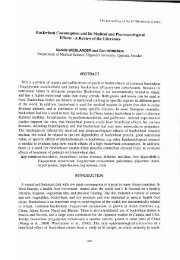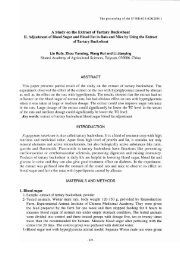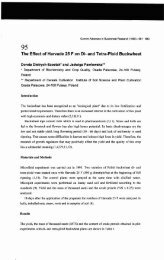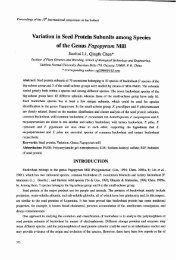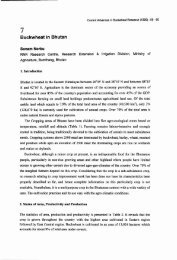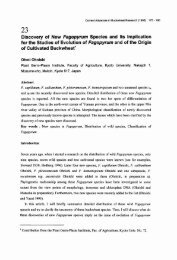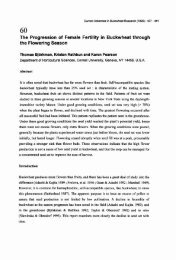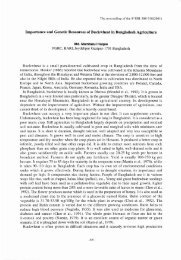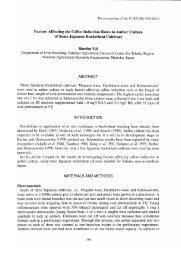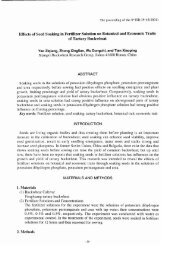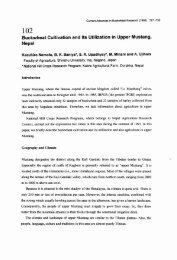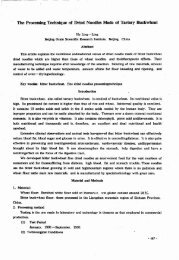Morphological and Genetic Aspects of Buckwheat Interspecific ...
Morphological and Genetic Aspects of Buckwheat Interspecific ...
Morphological and Genetic Aspects of Buckwheat Interspecific ...
Create successful ePaper yourself
Turn your PDF publications into a flip-book with our unique Google optimized e-Paper software.
Proceedings <strong>of</strong>the ](jh international symposium on buckwheat<br />
<strong>Morphological</strong> <strong>and</strong> <strong>Genetic</strong> <strong>Aspects</strong> <strong>of</strong> <strong>Buckwheat</strong><br />
<strong>Interspecific</strong> Incompatibility Overcoming<br />
Taranenko L.K., Yatsishen O.L., Taranenko P.P.<br />
The science-research Institute <strong>of</strong>Agriculture <strong>of</strong>the Ukrainian Academy <strong>of</strong>Agricultural Sciences<br />
Mashynobudivnykiv str; Zb, 08162 Chabany, Kyiv region, Ukraine<br />
Message 1. <strong>Genetic</strong> affinity among cultural buckwheat <strong>and</strong><br />
some <strong>of</strong>its wild species<br />
Abstract: Narrow polymorphism <strong>of</strong> buckwheat regarding particular elements <strong>of</strong> yield formula <strong>and</strong><br />
adaptive value requires researches on creation <strong>of</strong> the carriers <strong>and</strong> using them as donors. The necessary<br />
characteristics are related to some wild species . That is why involving these species into selection<br />
process as donors owning the criteria required for buckwheat characteristics improvement is an<br />
important question <strong>of</strong> the crop breeding.<br />
There are some facts about the reasons <strong>of</strong> remote combining disability <strong>of</strong> different flora resources,<br />
about full or particular sterility <strong>of</strong> young remote hybrids, very strong <strong>and</strong> hardly surmountable<br />
anesthesia in hybrids, low probability <strong>of</strong> interspecies hybrids characteristics <strong>and</strong> abilities recombination,<br />
<strong>and</strong> almost a total absence <strong>of</strong> generic hybrids recombination.<br />
A lot <strong>of</strong> hypothesis related to the incompatibility mechanism discovering give the evidence <strong>of</strong> very<br />
complicated processes, which are running at the moment <strong>of</strong> a plant pollination/fertilization together with<br />
enzyme systems <strong>and</strong> other biochemical complexes.<br />
Present-day development <strong>of</strong> genetic-<strong>and</strong>-selection science in conjunction with<br />
physiologic-<strong>and</strong>-biochemical science achievements open the possibilities to overcome the difficulties<br />
connected with interspecies incompatibility <strong>of</strong> many cultivated plants. Interspecies wheat-<strong>and</strong>-rye<br />
hybrids, barley-<strong>and</strong>-rye hybrids, interspecies tomatoes, cotton plants, soya, aborigine, tobacco, pea, bean,<br />
strawberry, pine hybrids <strong>and</strong> many other cultivated plants were created by using these achievements.<br />
In addition to this, common nature <strong>of</strong> interaction was discovered in the systems <strong>of</strong> remote<br />
interspecies <strong>and</strong> intergeneric incompatibility, <strong>and</strong> in the systems <strong>of</strong> intravariety incompatibility. At the<br />
same time, different methods were suggested to overcome all these types <strong>of</strong> incompatibility. These<br />
methods are based on suppression <strong>of</strong>incompatibility mechanism at different stages <strong>of</strong> its onset.<br />
Actually, all attempts to cross the cultivar with some wild species <strong>of</strong> buckwheat were not<br />
successful. In 1976 E. Grishyna conducted some researches crossing Tartary buckwheat with ordinary<br />
buckwheat. As a result, in some cases the ovary started to develop <strong>and</strong> reached about one-forth size <strong>of</strong> a<br />
matured yield. However, after that it <strong>of</strong>ten became brown <strong>and</strong> dried up. Similar researches results were<br />
collected by M. R. Morris in 1951 during reciprocal crossing between ordinary buckwheat <strong>and</strong> Tartary<br />
buckwheat at different stages <strong>of</strong> fertility.<br />
The only successful way to overcome interspecies incompatibility <strong>of</strong> buckwheat was achieved by E.<br />
132
Section B <strong>Genetic</strong> resources <strong>and</strong> breeding<br />
T. Danilenko <strong>and</strong> A. S. Kotov, as they obtained amphidiploids E gigantenum - interspecies hybrids - by<br />
crossing between wild species - E cymosum <strong>and</strong> E tatricum. General performance <strong>of</strong> the hybrid as well<br />
as its particular characteristics proves its hybrid origin: the hybrid was superior to its both parents in<br />
growth, leafiness, <strong>and</strong> yield. Its height reached up to 205m <strong>and</strong> the hybrid produced I02g <strong>of</strong> seeds,<br />
whereas the best specimen <strong>of</strong> Tartary buckwheat was only 1.68m high <strong>and</strong> produced 28g <strong>of</strong> seeds. The<br />
hybrid was more similar to its maternal plant in fetus shape <strong>and</strong> size as well as in the length <strong>of</strong> the<br />
vegetation season. At the same time it was more like its paternal plant in color <strong>and</strong> formation <strong>of</strong> the<br />
flower, way <strong>of</strong> pollination, lodging resistance, <strong>and</strong> branching habit.<br />
The fact that the hybrid has 32 chromosomes in its somatic cell, has superior seed yield, <strong>and</strong> both<br />
parents characteristics proves that it was developed by crossing between diploid sets <strong>of</strong> Tartary<br />
buckwheat <strong>and</strong> ordinary buckwheat. Allotetraploid origin <strong>of</strong> the hybrid is also proved by its biologic<br />
disintegration. If crossed with parents <strong>and</strong> ordinary buckwheat the amphidiploid does not seed properly<br />
developed hybrid seeds.<br />
Overcoming <strong>of</strong> buckwheat interspecies incompatibility by the examples <strong>of</strong> amphidiploids obtaining,<br />
genetic-<strong>and</strong>-selection science development in conjunction with physiologic-<strong>and</strong>-biochemical science<br />
achievements concerned about the methods how to overcome cross incompatibility <strong>of</strong> other crops<br />
taxonomic units presume such possibility in case <strong>of</strong> some other wild <strong>and</strong> cultivar buckwheat species<br />
hybridization.<br />
Keywords: Incompatibility; Hybridization; Recombination; <strong>Buckwheat</strong>; Growth-regulating substances;<br />
Embryo crop<br />
METHODS<br />
Researches on development <strong>of</strong> a method how to overcome interspecific combining disability <strong>of</strong> buckwheat<br />
where conducted at the National Scientific Centre <strong>of</strong> the Husb<strong>and</strong>ry under the Ukraine Academy <strong>of</strong> Agricultural<br />
Science, whereas biochemical, biotechnological <strong>and</strong>, partly, cytoembryological researches were doing at the<br />
Institute <strong>of</strong>Plant Physiology <strong>and</strong> at the Institute <strong>of</strong>Molecular Biology under the National Academy <strong>of</strong> Sciences <strong>of</strong><br />
Ukraine.<br />
Wild buckwheat species were involved during the researches.<br />
Etataricum Ggearth /2n =16/<br />
Etetratataricum /4n =32/<br />
Egiganteum Krot /4n =32/<br />
Ecymosum Meissn /4n =32/<br />
They used diploid varieties <strong>of</strong> the cultivar <strong>of</strong> Astra, self-consistent types, <strong>and</strong> tetraploid types as ordinary<br />
buckwheat. Cytoembryological, biochemical, <strong>and</strong> immunochemical characteristics were specified by different<br />
methods to determine genetic relationship between wild <strong>and</strong> cultivar buckwheat species. Karyotype description <strong>of</strong><br />
the wild species was done according to literature data, whereas chromosomes in metaphase plates <strong>of</strong> the radicles<br />
belonged to buckwheat cultivar types <strong>and</strong> E tataricum, which were fixed by the Karnua method <strong>and</strong> colored with<br />
acetocarmin by the Feulgen method, were calculated.<br />
In order to determine immunologic differences the<br />
analysis method developed by A. D. Volodarsky for plant tissue was used.<br />
Generative organs (pollen <strong>and</strong> pistils <strong>of</strong> buckwheat incompatible <strong>and</strong> compatible species) were analyzed in<br />
terms <strong>of</strong> immunodetection.<br />
For protein fractionation, disc electrophoresis in polyacrylamide gel method (The Ornstein-Davis<br />
electrophoretic system) was used. Micromethod (the diameter <strong>of</strong> gel pellets was 2mm <strong>and</strong> 4mm, the length was<br />
133
Proceedings <strong>of</strong>the 1d h international symposium on buckwheat<br />
4.5mm) was used because <strong>of</strong>the limited amount <strong>of</strong>histic material.<br />
<strong>Buckwheat</strong> seeds, anthers, <strong>and</strong> pistils with embryo sac were used as the material.<br />
RESULTS AND DISCUSSION<br />
Karyotype analyses <strong>of</strong> Eesculentum revealed the presence <strong>of</strong> 8 chromosomes in its haploid chromosome set.<br />
Their sizes varied from 3.78 to 6.97 mer. Its mapping was done by V. V. Mansurova in 1948.<br />
Karyotype analysis <strong>of</strong> E tatarium revealed that the karyotypes <strong>of</strong> Eesculentum <strong>and</strong> Etatarium are similar to<br />
each other in the number <strong>and</strong> shape <strong>of</strong> their large, small, <strong>and</strong> middle chromosomes. The essential difference <strong>of</strong><br />
Etatarium karyotype is a comparatively small size <strong>of</strong> its chromosomes, which vary from 2.0 mer to 3.3 mer, <strong>and</strong><br />
also slight difference in their lengths.<br />
The karyotye <strong>of</strong> E cymosum Meissn is different from the karyotypes <strong>of</strong> Eesculentum <strong>and</strong> Etatarium. The<br />
number <strong>of</strong> somatic chromosomes in this species is equal to 16 <strong>and</strong> 32. It can be assumed that this species has 4p as<br />
the result <strong>of</strong> natural chromosome doubling. The essential differences between E cymosum, Etatarium <strong>and</strong> E<br />
Tatarium karyotypes are the absence <strong>of</strong> accompanying chromosomes <strong>and</strong> the existence <strong>of</strong> supernumerary<br />
chromosomes with secondary constriction.<br />
The chromosomes <strong>of</strong> F. cymosum are bigger than the chromosomes <strong>of</strong> F.tataricum, but smaller than the<br />
chromosomes <strong>of</strong> F.esculentum, <strong>and</strong> their size is equal to 2.6 - 4.6 mkr.<br />
Karyotype analysis <strong>of</strong> E giganteum revealed that it has chromosomes, which are typical for the karyotypes <strong>of</strong><br />
initial species. This amphidiploid has 2 genomes <strong>of</strong>E tatricum <strong>and</strong> 2 genomes <strong>of</strong>ordinary buckwheat.<br />
Researches on the chromosome sets <strong>of</strong> the Astra, self-consistent type, <strong>and</strong> tetraploid buckwheat were done by<br />
using metaphase plates <strong>of</strong> radicles, which were fixed by the Karnua method <strong>and</strong> colored by the Feulgen method ,<br />
<strong>and</strong> were equal to 16 for diploid types <strong>and</strong> 32 for tetraploid buckwheat.<br />
Due to the fact that kryotype characteristics are insufficient to deduce the relation degree <strong>of</strong> species,<br />
researches on immunological <strong>and</strong> biochemical differences, which fully reveal this data, were conducted.<br />
As a consequence <strong>of</strong> the immunological researches, titer <strong>and</strong> specificity <strong>of</strong> the antiserum /AT/, which were<br />
obtained with the use <strong>of</strong> pollen <strong>and</strong> pistils <strong>of</strong> F. giganteum <strong>and</strong> F.esculentum /40/, revealed that after the reaction<br />
between the AT <strong>of</strong> these species <strong>and</strong> homologous antiserum the precipitation line was not specific.<br />
The pictures 1.1 <strong>and</strong> 1.2 show the fit <strong>of</strong> equivalent proportions <strong>of</strong> AT, related to pistils <strong>of</strong> E giganteum <strong>and</strong><br />
Eesculentum, to homologous antiserums.<br />
As nonspecific precipitate was formed in pollen system AG-AT, further precipitation test was not conducted.<br />
Equivalent proportion <strong>of</strong> AT-AG showed in the picture 1.1 is equal to 1:112, whereas in the picture 1.2 it is<br />
equal to 1:118. The number <strong>of</strong> precipitation lines shows that the antigenic spectrum <strong>of</strong>E giganteum pistils consists<br />
<strong>of</strong> two precipitates, while the antigenic spectrum <strong>of</strong> Eesculentum is formed by one line. Therefore, the antigenic<br />
spectrum <strong>of</strong>E giganteum is somewhat wider than the spectrum <strong>of</strong>Eesculentum.<br />
The data on partial similarity <strong>and</strong> partial difference between the antigenic mosaics <strong>of</strong> the two cultivars pistils<br />
is also proved by the gemological <strong>and</strong> geterological method by Uhtbrolny (Picture 1.3). Presence <strong>of</strong> common<br />
antigen is evident as horizontal precipitate was formed by immuno-diffusion reaction according to square scheme.<br />
Consequently, if the indicated cultivars <strong>of</strong> buckwheat are pollinated with pollen from one cultivar, the percentage<br />
<strong>of</strong> successful crossing will be markedly different. According to the empirical data, we can make the assumption<br />
that protein-protein interaction <strong>of</strong> pollen-pistil system lies at the root <strong>of</strong> incompatibility. Therefore, in order to<br />
improve crossing results, it is possible to use specific inhibitors or activators <strong>of</strong> protein synthesis, which can<br />
inactivate or activate protein synthesis systems <strong>of</strong> every crossing mate.<br />
134
Section B <strong>Genetic</strong> resources <strong>and</strong> breeding<br />
Picture 1.1 Comparison <strong>of</strong> buckwheat<br />
pistil antigenic stnIctures according to<br />
square scheme.<br />
I-AG <strong>of</strong> pistils<br />
2-AG <strong>of</strong> pistils<br />
Picture 1.2 Comparison <strong>of</strong> buckwheat pistil<br />
antigenic compositions.<br />
I-AG <strong>of</strong> pistils<br />
2-AG <strong>of</strong> pistils<br />
3-AC opposite pistils<br />
3-AC opposite pistils<br />
4-AC opposite pistils<br />
Picture 1.3 Precipitation reaction in agar between pistils AG <strong>and</strong> homologous<br />
antisenun.In the centrallunula is AS being opposite pistils in peripherallunulas· 1·5<br />
titrating /from 1 to 1I16,6-physiologicalsolution.<br />
In order to explore the possibility <strong>of</strong> testing the degree <strong>of</strong> genetic relationship between initial species <strong>and</strong><br />
their hybrids, examination <strong>of</strong> protein synthesis <strong>of</strong> their reproductive organs as well as their protein composition<br />
<strong>and</strong> quality was conducted.<br />
The detailed research data prove that such analysis can be used to estimate the degree <strong>of</strong> genetic relationship<br />
between buckwheat species (picture 1.4) where relationship coefficients are used as the criteria. These coefficients<br />
should be estimated for one species against another one as the ratio <strong>of</strong> the number <strong>of</strong> electrophoretic strips, which<br />
are common for both species electrophoregrams, to the number <strong>of</strong> electrophoretic strips <strong>of</strong> one species.<br />
order <strong>of</strong> the most representative strips is also used as the criteria. For instance, segments with very large protein<br />
amount IO.EP. 0.2-0.3/, <strong>and</strong> segments <strong>of</strong> easily mobile forms IO.E. 0-0.95-1.01 are considered to be representative.<br />
It should be noted that in segment with high electrophoretic mobility the first kind <strong>of</strong> strip related to E<br />
tatricum is comparatively more mobile than the same one related to Eesculentum. E tatricum has two clearly<br />
defmed strips, which are close to each other, whereas Eesculentum has only one.<br />
Arrangement <strong>of</strong> the strips with large protein amount in electrophoregrams <strong>of</strong> E giganteum seeds is more<br />
similar to the same arrangement <strong>of</strong> E tatricum, whereas in segments with high electrophoretic mobility there is<br />
only one strip (similar to Eesculentum).Therefore, such approach to the question gives the opportunity to estimate<br />
the degree <strong>of</strong> genetic relationship between different buckwheat species, which is an important thing for hybrids<br />
analysis <strong>and</strong> reproductive incompatibility forecasting during breeding.<br />
Having analyzed the data <strong>of</strong> karyological, immunochemical, <strong>and</strong> biochemical analysis, we note the fact <strong>of</strong> genetic<br />
relationship between E tatricum, E giganteum, <strong>and</strong> Eesculentum, <strong>Genetic</strong> relationship <strong>of</strong> E cymosum, whose<br />
The<br />
135
Proceedings a/the ](jh international symposium on buckwheat<br />
gene is a part <strong>of</strong> E giganteum, was implicitly determined by using the data <strong>of</strong> other researchers.<br />
0.2$<br />
0"'<br />
0.15<br />
I I<br />
O.BS<br />
0.90<br />
O.9S<br />
W<br />
1.0 !.-<br />
-<br />
Picture 1.4 Electrophoregram <strong>of</strong> protein composition <strong>of</strong><br />
buckwheat species (F.escuientum, F.giganteum, F.tatricum) seeds<br />
Message 2. Prospects <strong>of</strong><strong>Interspecific</strong> Hybridization in <strong>Buckwheat</strong><br />
Polymorphism Amplification<br />
Taranenko L.K., Yatsishen O.L., Karazhbej P.P., Taranenko P.P.<br />
The science-research Institute <strong>of</strong>Agriculture <strong>of</strong>the Ukrainian Academy <strong>of</strong>Agricultural Sciences<br />
Mashynobudivnykiv str; 2b, 08162 Chabany, Kyiv region, Ukraine<br />
F.esculentum (2n =16) x E tataricum (2n =16)<br />
/Astra species <strong>and</strong> incompatible species/<br />
Eesculentum (4n) x E tetrataricum (4n =32)<br />
/ tetraploid buckwheat x K-108/<br />
Eesculentum (4n) x E cymosum (4n =32)<br />
Eesculentum (4n) x E gigantueum (4n =32)<br />
/ tetraploid buckwheat! x / amphidiploid!<br />
METHODS<br />
Wild buckwheat seeds were received from the VIR collection. Plants <strong>of</strong> different buckwheat species were<br />
labeled according to flower formation. Individual legitimate pollinating <strong>of</strong> opposite heterostyled types was<br />
provided. The pollinating was being carried out every day in two ways - by transferring the pollen <strong>of</strong> one<br />
136
Section B <strong>Genetic</strong> resources <strong>and</strong> breeding<br />
buckwheat species to surfaces <strong>of</strong> clean, checked at magnification <strong>of</strong> x 7-10 stigmas belonged to plants with<br />
castrated flowers, <strong>and</strong> also by transferring the pollen to the stigmas <strong>of</strong> flower buds, which were previously opened<br />
up <strong>and</strong> castrated. In addition, thirty minutes before the hybridization, specific inhibitor <strong>of</strong> protein synthesis had<br />
been transformed to the stigmas. In one case the pollen was soaked in growth-activating substance <strong>and</strong> in the other<br />
case - growth stimulator was inserted after its transformation to stigmas. After having finished the crossing<br />
process the rest <strong>of</strong> mature flowers <strong>and</strong> stigmas were moved away.<br />
Crossing without physiologically active substances was considered as a st<strong>and</strong>ard for exemplified sachems.<br />
But during the mentioned process such kinds <strong>of</strong> growth-activating substances as actinomycin D - in concentration<br />
<strong>of</strong> 15mcglml, kinetin (0.1%) - IOmgIL, <strong>and</strong> also cadmium salt solutions in some concentrations were used.<br />
Pollen germination <strong>and</strong> growth intensity <strong>of</strong> pollen tubes were examined by using temporary specimens<br />
resulted from fixation <strong>of</strong> crossing products by the Karnua method after 1, 2, 4, 5, 6, 8, <strong>and</strong> 24 hoers after the<br />
crossing. Cultivation <strong>of</strong> 6-10 days embryos was done in embryo culture with use <strong>of</strong> Murasige-Skoog growing<br />
medium. True hybridism was cytologically <strong>and</strong> morphologically determined.<br />
RESULTS AND DISCUSSION<br />
In order to overcome cross incompatibility mechanism, growth-stimulating compositions were used. Most <strong>of</strong><br />
them were protein synthesis inhibitors <strong>and</strong> according to this fact incompatibility mechanism, which is admittedly<br />
has the nature <strong>of</strong> protein, should probably be weakened. We used such inhibitors <strong>of</strong> protein complex as<br />
chloramphenicol /chloromycetin/, antinomicin - D, <strong>and</strong> cadmium salt solutions - universal growth regulating<br />
compositions, which can effect growth inhibition as well as activate their growth stimulating property, depending<br />
on the time <strong>of</strong> the action. Kinetin is also a kind <strong>of</strong> growth stimulators, which was used during the experiment.<br />
The researches on buckwheat interspecific incompatibility overcoming were being conducted during 10<br />
vegetation periods as a field research <strong>and</strong> during 3 vegetation periods - as a greenhouse research.<br />
During this period <strong>and</strong> according to the hybridisation schemes 4003 flowers were crossed, on 11682 <strong>of</strong> them<br />
ovaries were formed, <strong>and</strong>, finally, 4934 complete seeds were formed as a result. Furthermore, 900 flowers were<br />
pollinated for cyto-control (Table 1.5).<br />
The largest amount <strong>of</strong> ovaries, when sampling was quite representational, were formed by the following<br />
combinations: Astra x F. tataricum v. rotundatum ( K-7)(31.3 %), tetraploid buckwheat x F.gigantcum (K -109)<br />
(27.2 %), during the hybridization tetraploid x F. tetratataricum (K - 108)(29.8 %) <strong>and</strong> tetraploid x perennial<br />
buckwheat (p. cymosum) (K-4231) - 15 %. The largest inferior yield (14.2 <strong>and</strong> 16.2 %) was obtained by the<br />
crossings where the Astra was used as a maternal component <strong>and</strong> two sorts <strong>of</strong> F. tataricum - as a paternal<br />
component.<br />
Results <strong>of</strong> the researches on efficiency <strong>of</strong> different physiologically active substances utilization in relation to<br />
level <strong>of</strong> seed set during the remote hybridization <strong>of</strong> buckwheat are listed in the table 1.5. The present data show<br />
that the largest amounts <strong>of</strong> ovaries <strong>and</strong> seeds are related to the following combinations: Astra x F. tataricum v.<br />
tuberculatuml K - 21/, Astra x K - 17 with using <strong>of</strong> stimulant <strong>and</strong> protector <strong>of</strong> cadmium salt; <strong>and</strong> also when using<br />
kinetin in such combinations as tetraploid buckwheat x K - 108 <strong>and</strong> as tetraploid buckwheat x K - 109.<br />
But at the same time, kinetin was less effective in combinations when the Astra was crossed with F. tataricum<br />
sorts.<br />
137
Proceedings <strong>of</strong>the ](jh international symposium on buckwheat<br />
Table 1.5 The level <strong>of</strong>seed set during interspecific buckwheat hybridization with use <strong>of</strong>growth-regulating substances<br />
Crossing<br />
combinations<br />
Growth-activating<br />
substances<br />
Dowers<br />
Average number <strong>of</strong><br />
ovaries<br />
seeds<br />
pieces % pieces<br />
%<br />
Control<br />
4046<br />
920<br />
22,7<br />
290<br />
7,7<br />
Astra x F. tataricum v.<br />
tuberculatum<br />
Kinetin + (DMSO (dimethyl<br />
sulfoxide)<br />
Cadmium salt +(DMSO)<br />
1116<br />
712<br />
354<br />
298<br />
31,7<br />
41,7<br />
144<br />
118<br />
12,9<br />
16,6<br />
ACT-D+DMSO<br />
836<br />
320<br />
38,2<br />
86<br />
10,2<br />
Control<br />
2128<br />
358<br />
16,8<br />
154<br />
7,2<br />
Tetraploid buckwheat x<br />
Kinetin +(DMSO)<br />
340<br />
172<br />
50,4<br />
68<br />
20,2<br />
F. tetratataricum Cadmium salt +(DMSO)<br />
1160<br />
244<br />
21,0<br />
100<br />
8,6<br />
ACT-D+ DMSO<br />
Control<br />
1354<br />
532<br />
19,6<br />
202<br />
7,5<br />
Tetraploid buckwheat x<br />
Kinetin +(DMSO)<br />
682<br />
278<br />
40,7<br />
128<br />
18,7<br />
F.gigantcum<br />
Cadmium salt +(DMSO)<br />
708<br />
134<br />
18,7<br />
14<br />
2,0<br />
ACT-D+ DMSO<br />
342<br />
40<br />
11,7<br />
2<br />
0,6<br />
Control<br />
1348<br />
206<br />
15,2<br />
50<br />
3,7<br />
Tetraploid buckwheat x<br />
Kinetin +(DMSO)<br />
F. cymosum Cadmium salt +(DMSO)<br />
ACT-D+ DMSO<br />
596<br />
156<br />
26,4<br />
34<br />
5,7<br />
Astra x<br />
Control<br />
1752<br />
184<br />
7,6<br />
44<br />
2,5<br />
F. tataricum<br />
Kinetin +(DMSO)<br />
758<br />
44<br />
5,8<br />
12<br />
1,5<br />
v.rotundatum<br />
Cadmium salt +(DMSO)<br />
626<br />
134<br />
21,4<br />
101<br />
16,3<br />
It is important to note that the main part <strong>of</strong> the formed inferiors died on the 6-12 day. Therefore, at the<br />
Institute <strong>of</strong> Microbiology <strong>and</strong> Hybridization 6-12 days ovaries were grown by use <strong>of</strong> embryo culture. Callus<br />
culture was bred <strong>and</strong> cloned. The created clones had been multiplying <strong>and</strong> growing till the time they attained the<br />
condition efreplanting to culture vessels <strong>of</strong> a plant house, <strong>and</strong> after that they were planted out into field conditions.<br />
/pictures 1.6 <strong>and</strong> 1.7/.<br />
138
Section B <strong>Genetic</strong> resources <strong>and</strong> breeding<br />
Picture 1.6 Plant F (Astra lit Rtataricum v,rotundatum<br />
K·17), grown from 10-12 days embryos, in embryo<br />
culture.<br />
Picture 1.7 <strong>Interspecific</strong> hybrids IAstra lit K·I71,<br />
replanted from embryo culture to vials.<br />
Picture 1.8<br />
Picture 1.9<br />
As a result <strong>of</strong> interspecific crossings, new morpho-phisio types <strong>of</strong> buckwheat were cultivated.<br />
Short-growing plants (up to 20sm) with strong, almost bush-like footstalks <strong>and</strong> bushy, branching crowns,<br />
little oval leafs, <strong>and</strong> short, nearly invisible petioles (picture 1.8) are <strong>of</strong> great value to buckwheat breeding.<br />
Inflorescences <strong>of</strong> these plants are in the shape <strong>of</strong> compact <strong>and</strong> small whorls, their stigmatized flowers have<br />
reduced petals <strong>and</strong> anthers, <strong>and</strong> considerable morphological anomalies.<br />
Dwarf plants are also <strong>of</strong> great interest. They have defining characteristics, which are as follows: strong stalks,<br />
stunting, well-developed foliage, which provides high photosynthetic potential (picture 1.9).<br />
The plants with unusual architectonics (picture 1.10), whose typical characteristics are tall flower-bearing<br />
stems, multiple inflorescences, consisted <strong>of</strong> 3-7 flower-bearing branches, are also <strong>of</strong>interest to the breeding<br />
concerned about intensive generative weight. The inflorescences <strong>of</strong> these plants are only over their vegetative<br />
weight <strong>and</strong> located within 15sm, whereas their foliage, in spite <strong>of</strong> being quite well-developed, is located within<br />
10sm. Such generative potential <strong>and</strong> leaf formation were taken from wild tetraploid species <strong>of</strong>F. tataricum K <br />
108. As the result, inflorescence structure was altered <strong>and</strong> such characteristic as brachysm was obtained. Cyto<br />
analyses proved that the plants have hybridous origin.<br />
By crossing between the Astra <strong>and</strong> F. tataricum v. rotundantum ( K - 2l)a dwarf plant (picture 1.11), whose<br />
139
Proceedings <strong>of</strong>the 10 th international symposium on buckwheat<br />
every branch is ended by a capitate inflorescence with stipules, was bred in second filial generation.<br />
Picture 1.10. Picture 1.11<br />
The hybrid plant which was obtained by crossing the Astra with F. tataricum v. rotundantum(picture 1. 12) is<br />
also <strong>of</strong> interest to buckwheat breeding concerned about high photosynthetic potential. Its characteristic is a tall<br />
<strong>and</strong> quite strong flower-bearing stem. It also has alternating <strong>and</strong> acuminate leafs with pronounced turning down<br />
<strong>and</strong> venation. The branches are at an acute angle to the main footstalk. Such branch arrangement reduces shading.<br />
Stunting <strong>and</strong> dwarf forms <strong>of</strong> interspecific hybrids with erectoid leaf <strong>and</strong> branch arrangement, with different<br />
types <strong>of</strong> inflorescences <strong>and</strong> different breeding performance (pictures 1.13, 1.14, 1.15, 1.16) are a valuable starting<br />
material for future breeding projects.<br />
Picture 1.12 Picture 1.13<br />
140
Section B <strong>Genetic</strong> resources <strong>and</strong> breeding<br />
Picture 1.14 Picture 1.15<br />
Picture 1.16<br />
SUMMARY<br />
According to imrnunobiochemical analysis <strong>and</strong> karyological characteristics, genetic relationship between<br />
wide species <strong>of</strong> buckwheat - F. tatricum, F. cymosum, their amphidiploid F. giganteum <strong>and</strong> cultural buckwheat<br />
was finally deduced.<br />
Among growth-activating <strong>and</strong> physiologically active substances used during the researches on buckwheat<br />
interspecific incompatibility overcoming the most effective were cadmium salts.<br />
It was proved by biological disintegration <strong>of</strong> the generation obtained after interspecific crossings <strong>and</strong> by<br />
morphological <strong>and</strong> cytoembryological researches that some particular selected interspecies hybrids have true<br />
hybrid origin.<br />
References<br />
[1] Kporos A. C., Ionyfeaa E. A . (1973). UHTOJlOIWIeCKOe asyseaae MeJKBH./lOBoro rn6pH./la F. tataricum x F. cymosum /I Tp. no<br />
npHKJla,nHoR 6oraHHKe, reaeraxe H CeJleKUHH. - 11.: BI1P. - T.51. - Bun. 1.<br />
[2] KPOTOB A . C., ):ij>aHeHKO E. T. (1973). AMcPH./lHnJlOH./l rpesaxa II EJOJlJI. BliP. - BhIII. 30. - c. 41-44.<br />
[3] Maacypona B. B. (1948). CPaBHHTeJIhHlUI KaPHOJlOrIDlllBYX BH./lOB rpesaxa: F. esculentum, F. emargihatum II )l.OKJI. AH CCCP.<br />
- T. 1. - Bsm. 6. - c. 119-122.<br />
[4] CypHKOB H. M. (1987). MOPcP0JlOrnqeCKHe, reaerasecxae H 3BOJlJOUHOHHbie acnexrsr reopaa BHyrpHBH./lOBOR H MeJKBHllOBOR<br />
nOJlOBOR HeCOBMeCTHMOCTH y UBeTKOBbIX pacreaaa II Ieaer-cenesn, acnexrsr CHCTeM pa3MHOJKeHIDI 3HTOM0cPHJlhHbIX BH./lOB<br />
paCTeHHR. Marepaansi I Bcecoiosaoro pa6. COBeUJ;aHHJI no rener-cenexnaoa, acnexrast CHCTeM pa3MHOJKeHHJI y 3HTOMOcP.<br />
BH./lOB pacreaaii /rpesaxa, XJI0nqaTHHK, mouepna/> )l.y1IlaH6e, 1-4oKT. 1985. - )l.yrnaH6e: )l.OHH1II. - c. 3-20.<br />
[5] TapaHeHKO 11. K. H IIp. (1987). Hexoropsre acnexrsr MeJKBHllOBOR rn6pH./lH3aUHH rpesaxa II Teneraxa, CeJleKllHJI,<br />
ceMeHOBOllCTBO H B03lleJlbIBaHHe spynsaux xynsryp, C6. aayxa. TPYllOB. - KH1IIHHeB:THnorpacPHJI KCXH. - c. 53-61.<br />
[6] Tatiana N. Lasareva, Ivan N . Fesenko (2004). Electrophoresis Spectra <strong>of</strong> Total Seed Protein <strong>of</strong> Artificial Amphidiploid<br />
Fagopyrum giganteum Krotov <strong>and</strong> its Parental Species F. tataricum ufaertn <strong>and</strong> F. cymosum Meisn. Proceedings <strong>of</strong> the 9 th<br />
International Symposim on <strong>Buckwheat</strong>. - Prague,p. 229-301.<br />
141




